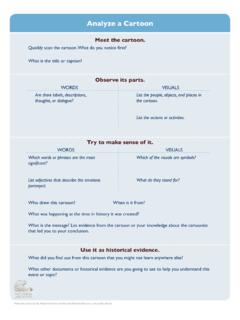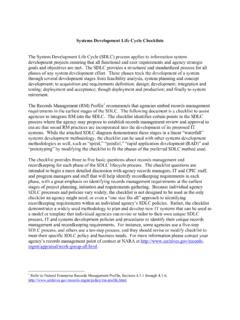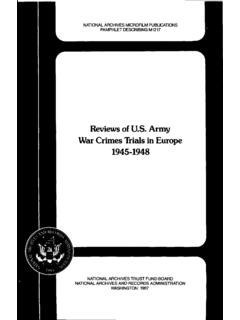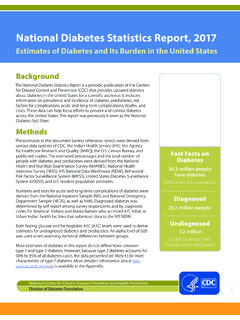Transcription of U.S. National Archives and Records Administration (NARA)
1 National Archives and Records Administration (NARA) Technical Guidelines for Digitizing Archival Materials for Electronic Access: Creation of Production Master Files Raster Images For the Following Record Types- Textual, Graphic Illustrations/Artwork/Originals, Maps, Plans, Oversized, Photographs, Aerial Photographs, and Objects/Artifacts June 2004 Written by Steven Puglia, Jeffrey Reed, and Erin Rhodes Digital imaging Lab, Special Media Preservation Laboratory, Preservation Programs National Archives and Records Administration 8601 Adelphi Road, Room B572, College Park, MD, 20740, USA Lab Phone: 301-837-3706 Email: Acknowledgements: Thank you to Dr. Don Williams for target analyses, technical guidance based on his extensive experience, and assistance on the assessment of digital capture devices. Thank you to the following for reading drafts of these guidelines and providing comments: Stephen Chapman, Bill Comstock, Maggie Hale, and David Remington of Harvard University; Phil Michel and Kit Peterson of the Library of Congress; and Doris Hamburg, Kitty Nicholson, and Mary Lynn Ritzenthaler of the National Archives and Records Administration .
2 SCOPE: The NARA Technical Guidelines for Digitizing Archival Materials for Electronic Access define approaches for creating digital surrogates for facilitating access and reproduction; they are not considered appropriate for preservation reformatting to create surrogates that will replace original Records . The Technical Guidelines presented here are based on the procedures used by the Digital imaging Lab of NARA s Special Media Preservation Laboratory for digitizing archival Records and the creation of production master image files, and are a revision of the 1998 NARA Guidelines for Digitizing Archival Materials for Electronic Access , which describes the imaging approach used for NARA s pilot Electronic Access Project. The Technical Guidelines are intended to be informative, and not intended to be prescriptive. We hope to provide a technical foundation for digitization activities, but further research will be necessary to make informed decisions regarding all aspects of digitizing projects.
3 These guidelines provide a range of options for various technical aspects of digitization, primarily relating to image capture, but do not recommend a single approach. The intended audience for these guidelines includes those who will be planning, managing, and approving digitization projects, such as archivists, librarians, curators, managers, and others. Another primary audience includes those actually doing scanning and digital capture, such as technicians and photographers. The following topics are addressed: o Digital Image Capture production master files, image parameters, digitization environment, color management, etc. o Minimum Metadata types, assessment, local implementation, etc. we have included a discussion of metadata to ensure a minimum complement is collected/created so production master files are useable o File Formats, Naming, and Storage recommended formats, naming, directory structures, etc.
4 O Quality Control image inspection, metadata QC, acceptance/rejection, etc. The following aspects of digitization projects are not discussed in these guidelines: o Project Scope define goals and requirements, evaluate user needs, identification and evaluation of options, cost-benefit analysis, etc. o Selection criteria, process, approval, etc. 1 National Archives and Records Administration - June 2004 2 NARA Technical Guidelines for Digitizing Archival Materials for Electronic Access: Creation of Production Master Files - Raster Images o Preparation archival/curatorial assessment and prep, Records description, preservation/conservation assessment and prep, etc. o Descriptive systems data standards, metadata schema, encoding schema, controlled vocabularies, etc. o Project management plan of work, budget, staffing, training, Records handling guidelines, work done in- house vs.
5 Contractors, work space, oversight and coordination of all aspects, etc. o Access to digital resources web delivery system, migrating images and metadata to web, etc. o Legal issues access restrictions, copyright, rights management, etc. o IT infrastructure determine system performance requirements, hardware, software, database design, networking, data/disaster recovery, etc. o Project Assessment project evaluation, monitoring and evaluation of use of digital assets created, etc. o Digital preservation long-term management and maintenance of images and metadata, etc. In reviewing this document, please keep in mind the following: o The Technical Guidelines have been developed for internal NARA use, and for use by NARA with digitizing projects involving NARA holdings and other partner organizations. The Technical Guidelines support internal policy directive NARA 816 Digitization Activities for Enhanced Access, at (NARA internal link only).
6 For digitization projects involving NARA holdings, all requirements in NARA 816 must be met or followed. o The Technical Guidelines do not constitute, in any way, guidance to Federal agencies on Records creation and management, or on the transfer of permanent Records to the National Archives of the United States. For information on these topics, please see the Records Management section of the NARA website, at and o As stated above, Federal agencies dealing with the transfer of scanned images of textual documents, of scanned images of photographs, and of digital photography image files as permanent Records to NARA shall follow specific transfer guidance ( and ) and the regulations in 36 CFR o The Technical Guidelines cover only the process of digitizing archival materials for on-line access and hardcopy reproduction. Other issues must be considered when conducting digital imaging projects, including the long- term management and preservation of digital images and associated metadata, which are not addressed here.
7 For information on these topics, please see information about NARA s Electronic Records archive project, at o The topics in these Technical Guidelines are inherently technical in nature. For those working on digital image capture and quality control for images, a basic foundation in photography and imaging is essential. Generally, without a good technical foundation and experience for production staff, there can be no claim about achieving the appropriate level of quality as defined in these guidelines. o These guidelines reflect current NARA internal practices and we anticipate they will change over time. We plan on updating the Technical Guidelines on a regular basis. We welcome your comments and suggestions. National Archives and Records Administration - June 2004 NARA Technical Guidelines for Digitizing Archival Materials for Electronic Access: Creation of Production Master Files - Raster Images TABLE OF CONTENTS: Scope - 1 Introduction - 5 Metadata - 5 o Common Metadata Types - 6 o Descriptive - 7 o Administrative - 8 o Rights - 8 o Technical - 9 o Structural - 10 o Behavior - 11 o Preservation - 11 o Image Quality Assessment - 12 o Records Management/Recordkeeping - 15 o Tracking - 15 o Meta-Metadata - 16 o Assessment of Metadata Needs for imaging Projects - 16 o Local Implementation - 18 o Relationships - 20 o Batch Level Metadata - 20 o Permanent and Temporary Metadata - 21 Technical Overview - 21 o Raster Image Characteristics.
8 O Spatial Resolution - 21 o Signal Resolution - 21 o Color Mode - 22 o Digitization Environment - 23 o Viewing Conditions - 23 o Monitor Settings, Light Boxes, and Viewing Booths - 23 o The Room - 23 o Practical Experience - 24 o Monitor Calibration - 24 o Quantifying Scanner/Digital Camera Performance - 24 o Test Frequency and Equipment Variability - 25 o Tests: Opto-Electronic Conversion Function (OECF) - 26 Dynamic Range - 26 Spatial Frequency Response (SFR) - 26 Noise - 27 Channel Registration - 27 Uniformity - 27 Dimensional Accuracy - 28 Other Artifacts or imaging Problems - 28 o Reference Targets - 29 o Scale and Dimensional References - 29 o Targets for Tone and Color Reproduction - 30 Reflection Scanning - 30 Transmission Scanning Positives - 30 Transmission Scanning Negatives - 31 imaging Workflow - 31 o Adjusting Image Files - 31 o Overview - 32 o Scanning Aimpoints - 32 o Aimpoints for Photographic Gray Scales - 35 o Alternative Aimpoints for Kodak Color Control Patches (color bars)
9 - 36 o Aimpoint Variability - 36 3 National Archives and Records Administration - June 2004 NARA Technical Guidelines for Digitizing Archival Materials for Electronic Access: Creation of Production Master Files - Raster Images o Minimum and Maximum Levels - 36 o Color Management Background - 36 o ICC Color Management System - 37 o Profiles - 37 o Rendering Intents - 38 o Color Management Modules - 38 o Image Processing - 38 o Color Correction and Tonal Adjustments - 39 o Sharpening - 39 o Sample Image Processing Workflow - 39 o Scanning - 40 o Post-Scan Adjustment/Correction - 40 Digitization Specifications for Record Types - 41 o Cleanliness of Work Area, Digitization Equipment, and Originals - 42 o Cropping - 42 o Backing Reflection Originals - 42 o Scanning Encapsulated or Sleeved Originals - 42 o Embossed Seals - 43 o Compensating for Minor Deficiencies - 43 o Scanning Text - 43 o Scanning Oversized - 44 o Scanning Photographs - 44 o Scanning Intermediates - 44 o Scanning Microfilm - 45 o Illustrations of Record Types - 46 o Requirements Tables.
10 O Textual Documents, Graphic Illustrations/Artwork/Originals, Maps, Plans, and Oversized - 51 o Photographs - Film/Camera Originals - Black-and-White and Color - Transmission Scanning - 52 o Photographs - Prints - Black-and-White, Monochrome, and Color - Reflection Scanning - 54 o Aerial - Transmission Scanning - 56 o Aerial - Reflection Scanning - 57 o Objects and Artifacts - 58 Storage - 60 o File Formats - 60 o File Naming - 60 o Directory Structure - 60 o Versioning - 61 o Naming Derivative Files - 61 o Storage Recommendations - 61 o Digital Repositories and Long-Term Management of Files and Metadata - 61 Quality Control - 62 o Completeness - 62 o Inspection of Digital Image Files - 62 o File Related - 62 o Original/Document Related - 62 o Metadata Related - 63 o Image Quality Related - 63 o Quality Control of Metadata - 64 o Documentation - 65 o Testing Results and Acceptance/Rejection - 65 Appendices: o A Digitizing for Preservation vs.















